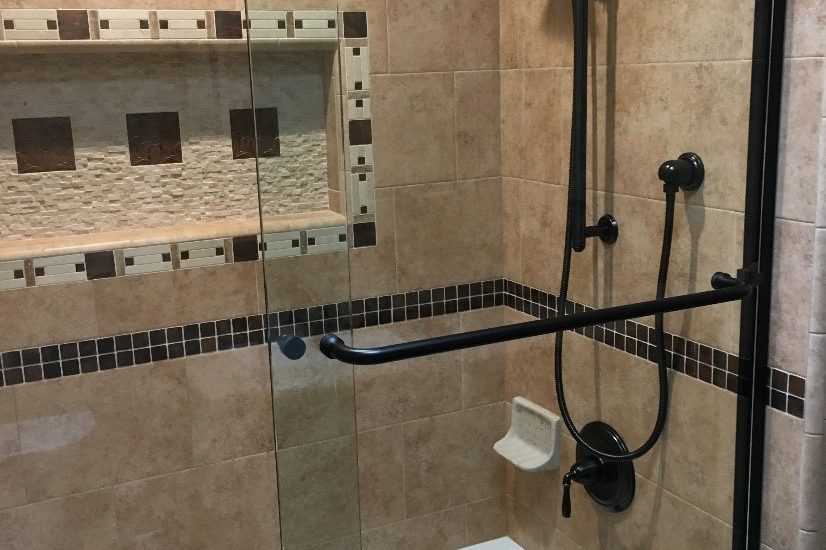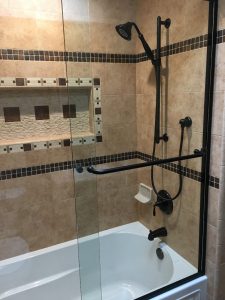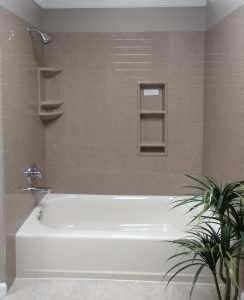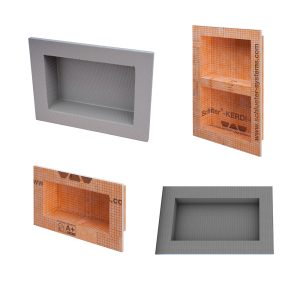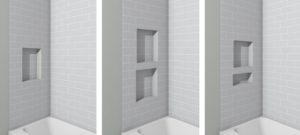Niche in the Bathtub
A niche in the bathtub is an extremely useful feature that provides you with a proper place to keep your bathing accessories, without adding bulky organizers that take up much-needed space. With a bathtub niche, storing shampoo and conditioner bottles, soap, razors, shaving cream, loofahs, and anything else you regularly use in the bathtub makes bathing much more convenient. They add functionality and style to your bathroom.
What Does a Niche in the Bathtub Look Like?
When considering a niche in the bathtub, tiled, solid surface, and prefabricated are the most common.
|
|
|
Tiled Niche in the Bathtub
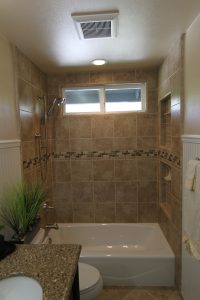
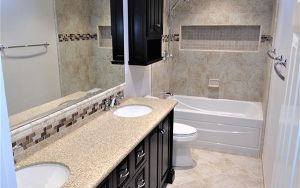 A tiled niche for the bathtub is the best. Why? Only a properly constructed tiled niche will provide you worry free convenience. A tiled niche can be along the back bathtub wall or on the side walls. The back wall offers a much bigger size while those on the side walls offer less visibility of stored items. Back wall bathtub niches not only accommodate more items, but they are more convenient to use while bathing. Those on a side wall require twisting and turning which can be dangerous and difficult with running, soapy water. Reaching for something behind you versus on the side of you increases the chances of a slip and fall incident.
A tiled niche for the bathtub is the best. Why? Only a properly constructed tiled niche will provide you worry free convenience. A tiled niche can be along the back bathtub wall or on the side walls. The back wall offers a much bigger size while those on the side walls offer less visibility of stored items. Back wall bathtub niches not only accommodate more items, but they are more convenient to use while bathing. Those on a side wall require twisting and turning which can be dangerous and difficult with running, soapy water. Reaching for something behind you versus on the side of you increases the chances of a slip and fall incident.
Tiled bathtub niches are completely integrated into the bathtub surround tile. There are no seams to leak or exposed outside corners to get moldy, slimy, and mildewy. Tiled bathtub niches can be customized to almost any size. This is not possible with solid surface and prefabricated niches.
Correctly installed, a tiled bathtub niche will last 40 years to a lifetime.
Solid Surface Niche
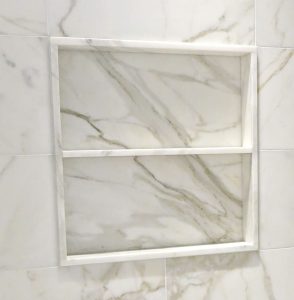 A solid surface niche is typically a cultured marble bathtub liner product and premade to a standard size.
A solid surface niche is typically a cultured marble bathtub liner product and premade to a standard size.
Solid niches are ready for tile after installation. Many have limited or no additional waterproofing requirements. This adds speed to your tile installation.
These bathtub niches look cheap and do little to bring warmth, beauty, and style to your bathroom. Customization for your specific needs is typically not possible. The seams tend to develop mineral deposit crusting and staining. The inside of these niches quickly develops a slimy staining and mineral crusting that changes the color of the product. I do not recommend these bathtub niches unless you are willing to thoroughly clean them a minimum of 2-3 times per week.
Solid niches offer lots of different shapes to choose from. These have a 20-year life expectancy.
Prefabricated Bathtub Niche
The most popular prefabricated bathtub niches are manufactured by Wedi®, Alfi®, Pulse®, and Schluter-Kerdi-Board®. Sizes and styles can be limited. These niches are very economical. Made from metal, plastic, Styrofoam, and polystyrene, waterproofing can be sketchy at best.
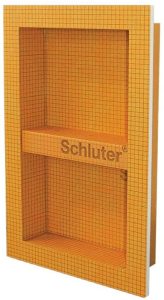 The most popular prefabricated niche is the Kerdi-Board 12 x 28-inch bathtub niche. It has a price range of $90-$140. Kerdi-Board niches are made with an extruded polystyrene foam panel. These panels have special reinforcement material on both sides and fleece webbing.
The most popular prefabricated niche is the Kerdi-Board 12 x 28-inch bathtub niche. It has a price range of $90-$140. Kerdi-Board niches are made with an extruded polystyrene foam panel. These panels have special reinforcement material on both sides and fleece webbing.
Polystyrene is a petroleum product. States have begun banning polystyrene products becuase they are not easily recycled or biodegradable. Egg cartons, coolers, packaging peanuts, and food service containers are all made using polystyrene.
These pre-made niches cannot be integrated like a fully tiled bathtub niche. This means they are subject to water intrusion on at least 4 different seam points. The only benefit these units provide are up front cost savings. I have personally seen many polystyrene bathtub systems fail in as little as 5 years after installation. DAD’s Construction only uses a fully integrated traditional cement application for its bathtub systems.
What Size Should My Niche in the Bathtub be?

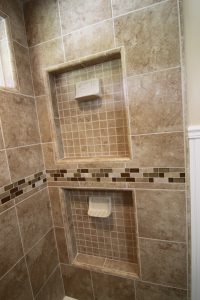 To answer this question, we will assume a tiled bathtub niche (since this is the best method to use). We will also look at bathtub niches on the back wall and on the side wall.
To answer this question, we will assume a tiled bathtub niche (since this is the best method to use). We will also look at bathtub niches on the back wall and on the side wall.
For both a back and side wall configuration, for the best comfort and performance you want a bathtub niche that is just above waist level. Waist level varies according to your height. If you are still not sure, consider 43 to 45-inches a good height.
Bathtub niches in tub/shower configurations require some additional considerations.
Generally, tub/showers are used by children. The bathtub is the primary vessel for bathing from toddler through preteen years. Teenage through early adult tub/showers are generally used for showering. The best niche in these instances are two, stacked niches. The bottom functions well for toddler through preteen while the upper niche is perfect as children grow into adults and primarily shower.
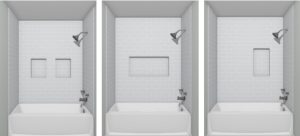 If there are two teenage children sharing the same tub/shower, each has their own niche. Having their own place to store their personal bathing items keeps the peace.
If there are two teenage children sharing the same tub/shower, each has their own niche. Having their own place to store their personal bathing items keeps the peace.
The length largely depends on the following:
- Your preference.
- Inside wall cavity framing.
- The year house was built.
- Depth of your bathtub.
- How many items you want to store.

For a standard 60-inch sized bathtub, a back wall niche should be about 44 to 48-inches long. Any longer and it begins to look odd, uncentered, and overbearing. The typical size for a side wall niche is between 12 and 16-inches.
The best height for both is 16-inches. This height allows for the larger shampoo and conditioner bottles.
Regardless of back or side wall niches, depth depends on your wall construction. A 2×4 wall will give you a finished depth of about 3-1/2 inches to 4-inches. A 2×6 wall provides a finished depth of about 5-1/2 inches to 6 inches.
What about Waterproofing a Niche in the Bathtub?
To ensure the lasting beauty of your new bathroom and protect your investment, a complete waterproofing system is essential.
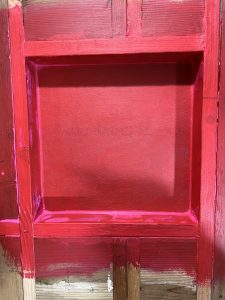 The water proofing system behind the tile and grout is paramount. Moisture that penetrates these areas and collects in the wall cavities or floor structure is the primary cause of leaks and mold. Creating a tiled bathtub that will last a lifetime requires a waterproofing system beneath the tile covering.
The water proofing system behind the tile and grout is paramount. Moisture that penetrates these areas and collects in the wall cavities or floor structure is the primary cause of leaks and mold. Creating a tiled bathtub that will last a lifetime requires a waterproofing system beneath the tile covering.
A bathtub niche must be waterproof. Waterproofing consists of an applied liquid elastomeric waterproofing membrane. Do not use cementitious boards (HardieBacker®, Durock®, Wonderboard®, GoBoard®, FiberRock®, etc.). In similar fashion, never use Kerdi-Board®, Schluter Kerdi-Bathtub System®, PVC bathtub liner, Pro-Slope™, asphalt emulsions, etc.
A properly constructed bathtub niche is the first step in enjoying an attractive, durable, and comfortable bathtub experience. They will fail if not constructed and waterproofed correctly. Serious personal injury and damage to your home may result. Always use an experienced Contractor such as DAD’s Construction. DAD’s Construction are experts on all phases of your bathtub remodel.
How Do I make my Bathtub Niche Stand Out?
Use a different tile inside the bathtub niche than the rest of the bathtub wall. This will make your niche stand out and act as a design feature that lifts your entire bathroom. On the flip side, using the same tile will make your bathtub niche blend in inconspicuously for a more monochromatic style.
Always Hire a Reliable and Dependable Contractor to Remodel your Bathtub
 Always work with a trustworthy contractor like DAD’s Construction. We are experts in bathtub and bathroom remodeling who can manage projects in an efficient manner. DAD’s Construction will do everything to minimize the possibility of change orders. Our team will make sure we have all the necessary information to prepare a proposal that meets your requirements. Rest assured that we will provide you with a detailed, by line-item contract. We will make sure that the contents of this agreement are properly and clearly communicated to you. If you have questions or need updates regarding your project, we will always answer your inquiries.
Always work with a trustworthy contractor like DAD’s Construction. We are experts in bathtub and bathroom remodeling who can manage projects in an efficient manner. DAD’s Construction will do everything to minimize the possibility of change orders. Our team will make sure we have all the necessary information to prepare a proposal that meets your requirements. Rest assured that we will provide you with a detailed, by line-item contract. We will make sure that the contents of this agreement are properly and clearly communicated to you. If you have questions or need updates regarding your project, we will always answer your inquiries.
How Can I Receive More Information on Remodeling my Bathroom Bathtub?
If you would like more information on enjoying the best bathroom, kitchen, and interior remodeling experience in Orange County, call Dan at (949) 380-0177 or at dan@dadsconstruction.com for a free in home consultation. DAD’s serves all of South Orange County California. This includes Lake Forest, Mission Viejo, Foothill Ranch, Portola Hills, Ladera Ranch, Irvine, San Clemente, Dana Point, San Juan Capistrano, Rancho Santa Margarita, Coto de Caza, Dove Canyon, Laguna Niguel, Laguna Hills, Laguna Beach, Newport Beach, and Aliso Viejo.
